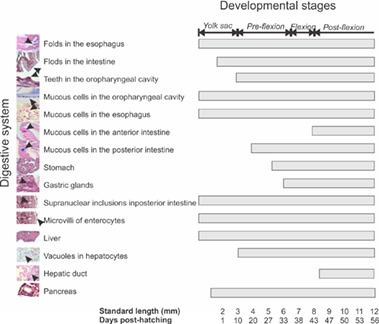当前位置:
X-MOL 学术
›
J. Morphol.
›
论文详情
Our official English website, www.x-mol.net, welcomes your
feedback! (Note: you will need to create a separate account there.)
Development of the digestive system of Argentine hake, Merluccius hubbsi , larvae
Journal of Morphology ( IF 1.5 ) Pub Date : 2020-04-09 , DOI: 10.1002/jmor.21122 Stefania Cohen 1, 2 , Marina V Diaz 2, 3 , Alcira O Díaz 1, 2
Journal of Morphology ( IF 1.5 ) Pub Date : 2020-04-09 , DOI: 10.1002/jmor.21122 Stefania Cohen 1, 2 , Marina V Diaz 2, 3 , Alcira O Díaz 1, 2
Affiliation

|
The Argentine hake Merluccius hubbsi is an important fishery resource of the Southwestern Atlantic Ocean and it is also a potential species for cultivation. In this work, the digestive system development in field‐caught hake larvae was studied using histological and histochemical approaches. The digestive tract of larvae was divided into: oropharyngeal cavity (OPC), esophagus, stomach (that develops in the preflexion stage), and intestine. The annexed digestive glands consisted of the liver and the exocrine pancreas. At the beginning of the preflexion stage, teeth were developed in the OPC. There were mucous cells in the esophagus secreting different glycoconjugates from hatching. The enterocytes in the posterior intestine exhibited supranuclear vesicles associated with protein absorption. Mucous cells were observed in the posterior intestine in the preflexion stage and, in the anterior region, ending the flexion stage. Each type of glycoconjugates has a specific role. Acidic mucins lubricate and protect from mechanical damage, sialomucines protect from bacterial infections and neutral mucins regulate the acidity of mucus secretion, protect against abrasion and participate in the formation of the chyme, indicating a pregastric digestion. The liver was present since hatching with pancreatic tissue inside and increased in size acquiring the typical structure with hepatocyte cords, sinusoids, vacuoles, and hepatic duct. The hepatocytes vacuolization increased with larval development. The pancreas became extra‐hepatic, with basophilic acinar cells and acidophilic zymogen granules. Throughout the ontogeny, the increased structural and functional complexity of the digestive system reflected the transition to exogenous feeding and nutritional increasing needs.
中文翻译:

阿根廷无须鳕、Merluccius hubbsi 幼虫消化系统的发育
阿根廷无须鳕是西南大西洋重要的渔业资源,也是潜在的养殖品种。在这项工作中,使用组织学和组织化学方法研究了野外捕获的无须鳕幼虫的消化系统发育。幼虫的消化道分为:口咽腔(OPC)、食道、胃(在前屈期发育)和肠。附属的消化腺由肝脏和外分泌胰腺组成。在前屈阶段的开始,牙齿在 OPC 中发育。食道中有黏液细胞从孵化中分泌不同的糖缀合物。后肠中的肠上皮细胞表现出与蛋白质吸收相关的核上囊泡。在前屈阶段在后肠中观察到粘液细胞,在前区,在屈曲阶段结束。每种类型的糖缀合物都有特定的作用。酸性粘蛋白润滑并防止机械损伤,唾液粘蛋白防止细菌感染,中性粘蛋白调节粘液分泌的酸度,防止磨损并参与食糜的形成,表明胃前消化。肝脏在孵化后就存在,里面有胰腺组织,并且体积增大,获得具有肝细胞索、血窦、空泡和肝管的典型结构。肝细胞空泡化随着幼虫的发育而增加。胰腺变为肝外,有嗜碱性腺泡细胞和嗜酸性酶原颗粒。在整个个体发育过程中,
更新日期:2020-04-09
中文翻译:

阿根廷无须鳕、Merluccius hubbsi 幼虫消化系统的发育
阿根廷无须鳕是西南大西洋重要的渔业资源,也是潜在的养殖品种。在这项工作中,使用组织学和组织化学方法研究了野外捕获的无须鳕幼虫的消化系统发育。幼虫的消化道分为:口咽腔(OPC)、食道、胃(在前屈期发育)和肠。附属的消化腺由肝脏和外分泌胰腺组成。在前屈阶段的开始,牙齿在 OPC 中发育。食道中有黏液细胞从孵化中分泌不同的糖缀合物。后肠中的肠上皮细胞表现出与蛋白质吸收相关的核上囊泡。在前屈阶段在后肠中观察到粘液细胞,在前区,在屈曲阶段结束。每种类型的糖缀合物都有特定的作用。酸性粘蛋白润滑并防止机械损伤,唾液粘蛋白防止细菌感染,中性粘蛋白调节粘液分泌的酸度,防止磨损并参与食糜的形成,表明胃前消化。肝脏在孵化后就存在,里面有胰腺组织,并且体积增大,获得具有肝细胞索、血窦、空泡和肝管的典型结构。肝细胞空泡化随着幼虫的发育而增加。胰腺变为肝外,有嗜碱性腺泡细胞和嗜酸性酶原颗粒。在整个个体发育过程中,











































 京公网安备 11010802027423号
京公网安备 11010802027423号